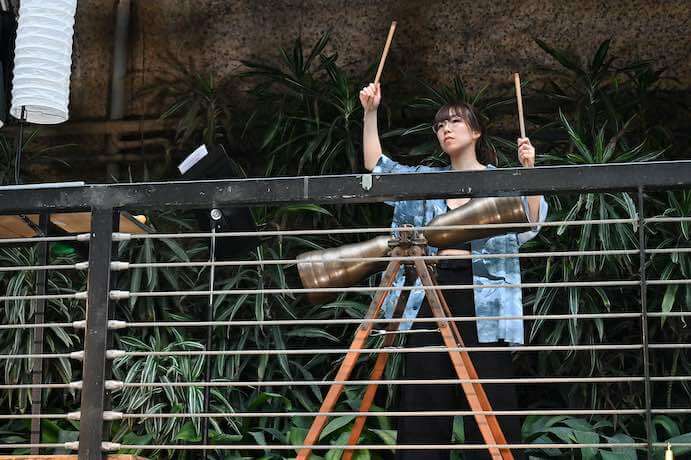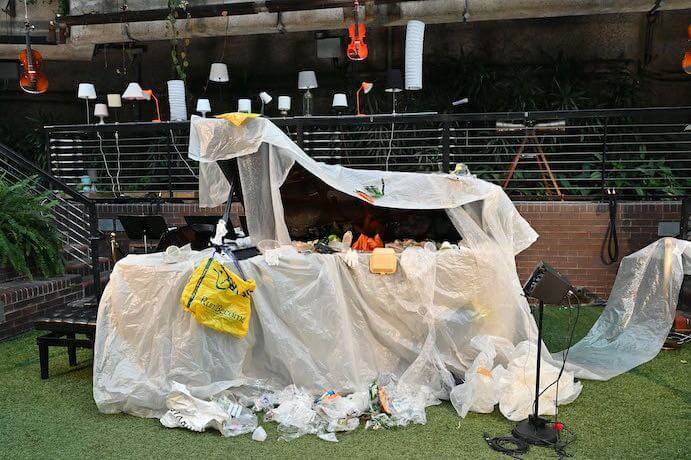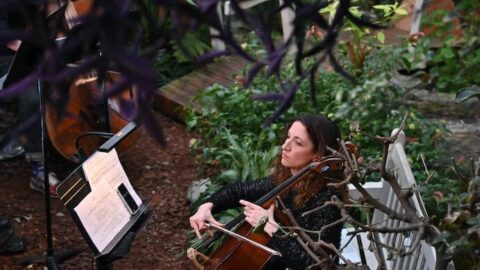London has more green space than many would assume, but its oldest part, now known as the City of London, is more like a concrete jungle today. Urban nature lovers in the City can, however, head to the third floor of the ultimate concrete estate that is the brutalist-architecture Barbican Centre and enjoy the hidden botanical garden in its Conservatory. This venue, with multiple water features and exotic plants draping over balconies, is occasionally used for performances, and, on March 12, Nonclassical took over the space to present a climate crisis-themed programme.
Founded by composer Gabriel Prokofiev in 2004, Nonclassical promotes new music via live events and recordings. They were pioneers in presenting cutting-edge new music in unconventional venues, often using electronics, and while the rest of the London scene has caught up with many of their ideas, Nonclassical continue to support new music as they approach their 20th anniversary.
The programme was presented as a sonic guided tour of the Barbican Conservatory. Prokofiev’s playful Tracing Contours, Lines & Planes led us into the venue. It was performed by the London Triangle Orchestra — a group of Nonclassical associates — playing rebar triangles made from the steel skeleton of the Barbican Centre. These rough-textured found objects were struck and stroked, the performers using the triangles to signal that the audience should move to a different area of the conservatory.
We started in a central artificial turf-covered space, surrounded by four huge bells designed by Marcus Vergette, an American musician and sculptor based in the U.K. His Tintinnabulation, for recorded bird calls, piano (Matthew Bourne), double bass (Vergette) and the four percussionists of Abstruckt was a curious combination of jazzy walking bass, nervy treble piano as if imitating birds, and multiple bell sounds. Audience members joined in on ocarina-like clay instruments, also made by Vergette, that represented birds. But the clanging of the magnificent bells was the piece’s most striking feature.

Quinta’s Aeolian Mixtape, for four strings, electronics and handmade Aeolian harps, inhabited a haunting sound world, with the stringed instruments again in dialogue with recorded birds. The Aeolian harps, made by Quinta during a Greek residency, are breeze-activated and their natural spontaneity represented a true fusion of nature and music.
The percussionists of Abstruckt appeared in different locations of the conservatory, performing a selection of ensemble pieces from the U.S., impressively negotiating the intricate phasing of an extract of Reich’s Music for Pieces of Wood while walking to a new performance area. Andy Akiho’s Pillar IV, for percussion quartet, combined delicately-struck tuned instruments with found objects, including plastic bottles, as did the third movement of David Lang’s So Called Laws of Nature, in which mugs and flowerpots blended with chime bars. Abstruckt performed with easy virtuosity, wit and flair — characteristic of the best contemporary percussion ensembles.
Claudia Molitor’s Polymer Hauntings was a surprise. We returned to the piano performance space to find the Bösendorfer covered in plastic sheeting and detritus, and with many plastic bottles and bowls placed on the strings. Molitor describes the piece as a requiem for single-use plastics that “aims to be unperformable in the near future,” when this type of packaging has been phased out. It starts with a fairly conventional piano figuration, though with the sound distorted, especially in the bass register where pitch struggled to be heard, as if suffocated by the plastic. Polymer Hauntings was performed by the adventurous pianists Katherine Tinker and Yshani Perinpanayagam, Tinker venturing inside the piano to pluck strings, and Perinpanayagam, wearing a bubble wrap coat, encouraging the audience to make sounds with the plastic rubbish.

With the plastic cleared from the performance area and the natural light fading, Carola Bauckholt’s Doppelbelichtung (“Double exposure”), for amplified violin and electronics, began. This is one of a series of pieces by Bauckholt based on birdsong, here with recorded birds diffused from one speaker to another, as if in flight, and the violinist imitating the birds as closely as possible. Linda Jankowska and her violin were uncanny bird mimics; the dialogue between the recording of nature and its instrumental simulacrum was a perfect fit for the created natural environment for the Barbican Conservatory.
Nonclassical’s concert was, typically for them, an immaculately performed voyage of discovery in a fascinating space. But while the conservatory was a lovely place to visit, it is not an accessible venue: the multiple changes of scene and lack of seating in some parts might have made the visit uncomfortable or difficult for some people. Nonclassical suggested that the concert might encourage the audience to “reflect on our relationship with nature,” and specifically with the contemporary climate emergency. The different pieces showed how we use, tame, interact with, and — in Molitor’s piece — destroy our environment.
I CARE IF YOU LISTEN is an editorially-independent program of the American Composers Forum, and is made possible thanks to generous donor and institutional support. Opinions expressed are solely those of the author and may not represent the views of ICIYL or ACF.
You can support the work of ICIYL with a tax-deductible gift to ACF. For more on ACF, visit the “At ACF” section or composersforum.org.
























